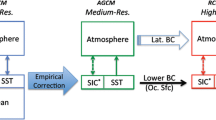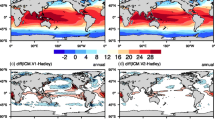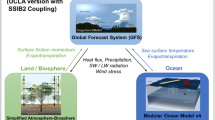Abstract
This study documents methodological issues arising when downscaling modes of large-scale atmospheric variability with a regional climate model, over a remote region that is yet under their influence. The retained case study is El Niño Southern Oscillation and its impacts on Southern Africa and the South West Indian Ocean. Regional simulations are performed with WRF model, driven laterally by ERA40 reanalyses over the 1971–1998 period. We document the sensitivity of simulated climate variability to the model physics, the constraint of relaxing the model solutions towards reanalyses, the size of the relaxation buffer zone towards the lateral forcings and the forcing fields through ERA-Interim driven simulations. The model’s internal variability is quantified using 15-member ensemble simulations for seasons of interest, single 30-year integrations appearing as inappropriate to investigate the simulated interannual variability properly. The incidence of SST prescription is also assessed through additional integrations using a simple ocean mixed-layer model. Results show a limited skill of the model to reproduce the seasonal droughts associated with El Niño conditions. The model deficiencies are found to result from biased atmospheric forcings and/or biased response to these forcings, whatever the physical package retained. In contrast, regional SST forcing over adjacent oceans favor realistic rainfall anomalies over the continent, although their amplitude remains too weak. These results confirm the significant contribution of nearby ocean SST to the regional effects of ENSO, but also illustrate that regionalizing large-scale climate variability can be a demanding exercise.














Similar content being viewed by others
References
Alexandru A, De Elia R, Laprise R (2007) Internal variability in regional climate downscaling at the seasonal scale. Mon Weather Rev 135:3221–3238
Bielli S, Douville H, Pohl B (2010) Understanding the West African monsoon variability and its remote effects: an illustration of the grid point nudging methodology. Clim Dyn 35:159–174. doi:10.1007/s00382-009-0667-8
Chen F, Dudhia J (2001) Coupling an advanced land-surface/hydrology model with the Penn State/NCAR MM5 modelingsystem. Part I: model description and implementation. Mon Weather Rev 129:569–585
Cook KH (2000) The South Indian convergence zone and interannual rainfall variability over Southern Africa. J Clim 13:3789–3804
Cook KH (2001) A Southern Hemisphere wave response to ENSO with implications for southern Africa precipitation. J Atmos Sci 15:2146–2162
Crétat J (2011) Pluviométrie et circulation atmosphérique simulées par le modèle régional WRF en Afrique australe: sensibilité à la physique et variabilité interne. Ph.D. dissertation, University of Burgundy, 273 pp
Crétat J, Pohl B (2012) How physical parameterizations can modulate internal variability in a regional climate model. J Atmos Sci 69:714–724. doi:10.1175/JAS-D-11-0109.1
Crétat J, Macron C, Pohl B, Richard Y (2011) Quantifying internal variability in a regional climate model: a case study for Southern Africa. Clim Dyn 37:1335–1356. doi:10.1007/s00382-011-1021-5
Crétat J, Pohl B, Richard Y, Drobinski P (2012a) Uncertainties in simulating regional climate of Southern Africa: sensitivity to physical parameterizations using WRF. Clim Dyn 38:613–634. doi:10.1007/s00382-011-1055-8
Crétat J, Richard Y, Pohl B, Rouault M, Reason CJC, Fauchereau N (2012b) Recurrent daily rainfall patterns over South Africa and associated dynamics during the core of the austral summer. Int J Climatol 32:261–273. doi:10.1002/joc.2266
Davis C, Wang W, Chen SS, Chen Y, Corbosiero K, DeMaria M, Dudhia J, Holland G, Klemp J, Michalakes J, Reeves H, Rotunno R, Snyder C, Xiao Q (2008) Prediction of landfalling hurricanes with advanced hurricane WRF model. Mon Weather Rev 136:1990–2005
Dee DP, Uppala SM, Simmons AJ, Berrisford P, Poli P, Kobayashi S, Andrae U, Balmaseda MA, Balsamo G, Bauer P, Bechtold P, Beljaars ACM, van de Berg L, Bidlot J, Bormann N, Delsol C, Dragani R, Fuentes M, Geer AJ, Haimberger L, Healy SB, Hersbach H, Holm EV, Isaksen L, Kallberg P, Kohler M, Matricardi M, McNally AP, Monge-Sanz BM, Morcrette J–J, Park B-K, Peubey C, de Rosnay P, Tavolato C, Thepaut J-N, Vitart F (2011) The ERA-Interim reanalysis: configuration and performance of the data assimilation system. Q J R Meteorol Soc 137:553–597. doi:10.1002/qj.828
Denis B, Laprise R, Caya D, Côté J (2002) Downscaling ability of one-way-nested regional climate models: The Big-Brother experiment. Clim Dyn 18:627–646
Denis B, Laprise R, Caya D (2003) Sensitivity of a Regional Climate Model to the spatial resolution and temporal updating frequency of the lateral boundary conditions. Clim Dyn 20:107–126
Dudhia J (1989) Numerical study of convection observed during the winter experiment using a mesoscale two-dimensional model. J Atmos Sci 46:3077–3107
Engelbrecht FA, de Rautenbach CJW, McGregor JL, Katzfey JJ (2002) January and July climate simulations over the SADC region using the limited area model DARLAM. Water SA 28:361–373
Fauchereau N, Pohl B, Reason CJC, Rouault M, Richard Y (2009) Recurrent daily OLR patterns in the Southern Africa/Southwest Indian Ocean region, implications for South African rainfall and teleconnections. Clim Dyn 32:575–591. doi:10.1007/s00382-008-0426-2
Giorgi F, Bi X (2000) A study of internal variability of a regional climate model. J Geophys Res 105(29):503–529, 521
Giorgi F, Mearns LO (1991) Approaches to the simulation of regional climate change: a review. Rev Geophys 29(2):191–216. doi:10.1029/90RG02636
Grell GA, Dévényi D (2002) A generalized approach to parameterizing convection combining ensemble and data assimilation techniques. Geophys Res Lett 29:1693. doi:10.1029/2002GL015311
Haensler A, Hagemann S, Jacob D (2011a) Dynamical downscaling of ERA40 reanalysis data over southern Africa: added value in the simulation of the seasonal rainfall characteristics. Int J Climatol 31:2338–2349. doi:10.1002/joc.2242
Haensler A, Hagemann S, Jacob D (2011b) The role of the simulation setup in a long-term high-resolution climate change projection for the southern African region. Theor Appl Climatol. doi:10.1007/s00704-011-0420-1 published on line
Hong SY, Noh Y, Dudhia J (2006) A new vertical diffusion package with an explicit treatment of entrainment processes. Mon Weather Rev 134:2318–2341
Hudson DA, Jones RG (2002) Regional climate model simulations of present-day and future climates of southern Africa. Hadley Centre Technical Note N 39, 42 pp
Ibrahim B, Polcher J, Karambiri H, Rockel B (2012) Characterization of the rainy season in Burkina Faso and it’s representation by regional climate models. Clim Dyn. doi:10.1007/s00382-011-1276-x published on line
Janjic ZI (2002) Nonsingular implementation of the Mellor–Yamada level 2.5 scheme in the NCEP meso model. NCEP Office Note N437, 61 pp
Joubert AM, Katzfey JJ, McGregor JL, Ngunyen KC (1999) Simulating midsummer climate over southern Africa using a nested regional climate model. J Geophys Res 104:19015–19025
Jury MR (2002) Economic impacts of climate variability in South Africa and development of resource prediction models. J Appl Meteorol 41:46–55
Kain JS (2004) The Kain–Fritsch convective parameterization: an update. J Appl Meteorol 43:170–181
Kim EJ, Hong SY (2010) Impact of air-sea interaction on East Asian summer monsoon climate in WRF. J Geophys Res 115:D19118
Landman WA, Beraki A (2012) Multi-model forecast skill for midsummer rainfall over southern Africa. Int J Climatol 32:303–314. doi:10.1002/joc.2273
Landman WA, Kgatuke MM, Mbedzi M, Beraki A, Bartman A, du Piesanie A (2009) Performance comparison of some dynamical and empirical downscaling methods for South Africa from a seasonal climate modelling perspective. Int J Climatol 29:1535–1549. doi:10.1002/joc.1766
Laprise R (2008) Regional climate modelling. J Comput Phys 227:3641–3666
Lindesay JA (1988) South African rainfall, the southern oscillation and a southern hemisphere semi-annual cycle. J Climatol 8:17–30
Lucas-Picher P, Caya D, De Elia R, Laprise R (2008a) Investigation of regional climate models’ internal variability with a ten member ensemble of 10-year simulations over a large domain. Clim Dyn 31:927–940
Lucas-Picher P, Caya D, Biner S, Laprise R (2008b) Quantification of the lateral boundary forcing of a regional climate model using an aging tracer. Mon Weather Rev 136:4980–4996
Lynch SD (2003) Development of a RASTER database of annual, monthly and daily rainfall for Southern Africa. WRC report N1156/1/03, 78 pp
Lyon B, Mason SJ (2007) The 1997–98 summer rainfall season in Southern Africa. Part I: Observations. J Clim 20:5134–5148. doi:10.1175/JCLI4225.1
Lyon B, Mason SJ (2009) The 1997–98 summer rainfall season in Southern Africa. Part II: model simulations and coupled model forecasts. J Clim 22:3802–3818. doi:10.1175/2009JCLI2600.1
Mellor GL, Yamada T (1982) Development of a turbulence closure model for geophysical fluid problems. Rev Geophys Space Phys 20:851–875
Misra V (2002) The influence of Pacific SST variability on the precipitation over Southern Africa. J Clim 16:2408–2418
Mlawer E, Taubman S, Brown P, Iacono M, Clough S (1997) Radiative transfer for inhomogeneous atmosphere: RRTM, a validated correlated-k model for the long-wave. J Geophys Res 102:16663–16682
Morrison H, Thompson G, Tatarskii V (2009) Impact of cloud microphysics on the development of trailing stratiform precipitation in a simulated squall line: comparison of one- and two-moment schemes. Mon Weather Rev 137:991–1007
Mulenga HM (1998) Southern African climatic anomalies, summer rainfall and the Angola low. PhD Thesis, University of Cape Town, Cape Town, South Africa, 232 pp
Mutai CC, Ward MN (2000) East African rainfall and the tropical circulation/convection on intraseasonal to interannual timescales. J Clim 13:3915–3939
Nicholson SE (1997) An analysis of the ENSO signal in the tropical Atlantic and western Indian oceans. Int J Climatol 17:345–375
Nicholson S (2003) Comments on ‘‘The South Indian Convergence Zone and Interannual Rainfall Variability over Southern Africa’’ and the Question of ENSO’s Influence on Southern Africa. J Clim 16:555–562
Nicholson SE, Kim J (1997) The relationship of the El Niño-Southern Oscillation to African rainfall. Int J Climatol 17:117–135
Pal JS, Giorgi F, Bi XQ, Elguindi N, Solmon F, Gao XJ, Ashfaq M, Francisco R, Bell J, Diffenbaugh N, Sloan L, Steiner A, Winter J, Zakey A (2007) The ICTP RegCM3 and RegCNET: regional climate modeling for the developing world. BAMS 88:1395–1409
Poccard I, Janicot S, Camberlin P (2000) Comparison of rainfall structures between NCEP/NCAR reanalyses and observed data over Tropical Africa. Clim Dyn 16:897–915
Pohl B, Douville H (2011) Diagnosing GCM errors over West Africa using relaxation experiments. Part I: Summer monsoon climatology and interannual variability. Clim Dyn 37:1293–1312. doi:10.1007/s00382-010-0911-2
Pohl B, Richard Y, Fauchereau N (2007) Influence of the Madden-Julian Oscillation on southern African summer rainfall. J Clim 20:4227–4242
Pohl B, Fauchereau N, Richard Y, Rouault M, Reason CJC (2009) Interactions between synoptic, intraseasonal and interannual convective variability over Southern Africa. Clim Dyn 33:1033–1050. doi:10.1007/s00382-008-0485-4
Pollard RT, Rhines PB, Thompson RORY (1973) The deepening of the wind-mixed layer. Geophys Fluid Dyn 3:381–404
Ratnam J, Behera S, Masumoto Y, Takahashi K, Yamagata T (2011) A simple regional coupled model experiment for summer-time climate simulation over southern Africa. Clim Dyn. doi:10.1007/s00382-011-1190-2 published on line
Reason CJC, Jagadheesha D (2005a) A model investigation of recent ENSO impacts over southern Africa. Meteorol Atm Phys 89:181–205
Reason CJC, Jagadheesha D (2005b) Relationships between South Atlantic SST Variability and Atmospheric Circulation over the South African Region during Austral Winter. J Clim 18:3339–3355. doi:10.1175/JCLI3474.1
Reason CJC, Allan RJ, Lindesay JA, Ansell TJ (2000) ENSO and climatic signals across the Indian Ocean basin in the global context: part I, Interannual composite patterns. Int J Climatol 20:1285–1327
Richard Y, Trzaska S, Roucou P, Rouault M (2000) Modification of the Southern African rainfall variability/El Nin˜o southern oscillation relationship. Clim Dyn 16:883–895
Richard Y, Fauchereau N, Poccard I, Rouault M, Trzaska S (2001) XXth century droughts in Southern Africa: spatial and temporal variability, teleconnections with oceanic and atmospheric conditions. Int J Climatol 21:873–885
Rouault M, Penven B, Pohl B (2009) Warning in the Agulhas Current system since the 1980s. Geophys Res Lett 36:L12602. doi:10.1029/2009GL037987
Rouault M, Pohl B, Penven P (2010) Coastal oceanic climate change and variability from 1982 to 2009 around South Africa. Afr J Mar Sci 32:237–246
Rummukainen M (2010) State-of-the-art with regional climate models. Wiley Interdisciplinary Reviews. Clim Change 1:82–96. doi:10.1002/wcc.8
Separovic L, de Elia R, Laprise R (2008) Reproducible and irreproducible components in ensemble simulations with a regional climate model. Mon Weather Rev 136:4942–4961. doi:10.1175/2008MWR2393.1
Separovic L, de Elia R, Laprise R (2012) Impact of spectral nudging and domain size in studies of RCM response to parameter modification. Clima Dyn 38:1325–1343. doi:10.1007/s00382-011-1072-7
Simmons A, Uppala S, Dee D, Kobayashi S (2007) ERA-interim: new ECMWF reanalysis products from 1989 onwards. ECMWF Newslett 110:25–35
Skamarock WC, Klemp JB, Dudhia J, Gill DO, Barker DM, Duda M, Huang XY, Wang W, Powers JG (2008) A description of the advanced research WRF version 3. NCAR technical note, NCAR/TN\u2013475?STR, 123 pp
Taljaard JJ (1986) Change of rainfall distribution and circulation patterns over southern Africa in summer. Int J Climatol 6:579–592. doi:10.1002/joc.3370060602
Tennant W (2004) Considerations when using pre-1979 NCEP/NCAR reanalyses in the southern hemisphere. Geophys Res Lett 31:L11112. doi:10.1029/2004GL019751
Todd M, Washington R (1999) Circulation anomalies associated with tropical-temperate troughs in southern Africa and the southwest Indian Ocean. Clim Dyn 15:937–951
Todd MC, Washington R, Palmer PI (2004) Water vapour transport associated with tropical-temperate trough systems over Southern Africa and the southwest Indian Ocean. Int J Climatol 24:555–568
Trenberth KE (1991) Climate diagnostics from global analyses: conservation of mass in ECMWF analyses. J Clim 4:707–722
Trenberth KE, Stepaniak P, Hurrell JW, Fiorino M (2001) Quality of reanalyses in the Tropics. J Clim 14:1499–1510
Uppala SM, Kallberg PW, Simmons AJ, Andrae U, Bechtold VDC, Fiorino M, Gibson JK, Haseler J, Hernandez A, Kelly GA, Li X, Onogi K, Saarinen S, Sokka N, Allan RP, Andersson E, Arpe K, Balmaseda MA, Beljaars ACM, Van de Berg L, Bidlot J, Bormann N, Caires S, Chevallier F, Dethof A, Dragosavac M, Fisher M, Fuestes M, Hagemann S, Holm E, Hoskins BJ, Isaksen L, Janssen PAEM, Jenne R, MnNally AP, Mahfouf J-F, Morcrette J–J, Rayner NA, Saunders RW, Simon P, Sterl A, Trenberth KE, Untch A, Vasiljevic D, Viterbo P, Woollon J (2005) The ERA-40 re-analysis. Q J R Meteorol Soc 131:2961–3012
Usman MT, Reason CJC (2004) Dry spell frequencies and their variability over Southern Africa. Clim Res 26:199–211
Vigaud N, Richard Y, Rouault M, Fauchereau N (2007) Water vapour transport from the Tropical Atlantic and summer rainfall in Tropical Southern Africa. Clim Dyn 28:113–123
Vigaud N, Richard Y, Rouault M, Fauchereau N (2009) Moisture transport between the South Atlantic Ocean and Southern Africa: relationships with summer rainfall and associated dynamics. Clim Dyn 32:113–123
Vigaud N, Pohl B, Crétat J (2012) Tropical-temperate interactions over southern Africa simulated by a regional climate model. Clim Dyn (in press)
Washington R, Preston A (2006) Extreme wet years over southern Africa: Role of Indian Ocean sea surface temperatures. J Geophys Res 111:D15104. doi:10.1029/2005JD006724
Washington R, Todd M (1999) Tropical-temperate links in southern Africa and southwest Indian Ocean satellite-derived daily rainfall. Int J Climatol 19:1601–1616
Williams CJR, Kniveton DR, Layberry R (2010) Assessment of a climate model to reproduce rainfall variability and extremes over Southern Africa. Theor Appl Climatol 99:9–27. doi:10.1007/s00704-009-0124-y
Wolter K, Timlin MS (1993) Monitoring ENSO in COADS with a seasonally adjusted principal component index. In: 17th Climate diagnostics workshop, Norman, OK, pp 52–57
Xie P, Janowiak JE, Arkin PA, Adler R, Gruber A, Ferraro R, Huffman GJ, Curtis S (2003) GPCP pentad precipitation analyses: an experimental dataset based on gauge observations and satellite estimates. J Clim 16:2197–2214
Yang X, DelSole T (2012) Systematic comparison of ENSO teleconnection patterns between models and observations. J Clim 25:425–446. doi:10.1175/JCLI-D-11-00175.1
Zhong Z, Wang X, Lu W, Hu Y (2010) Further study on the effect of buffer zone size on regional climate modeling. Clim Dyn 35:1027–1038
Acknowledgments
This article is part of the first author’s MSc thesis funded by the FABER program of the Burgundy region and is a contribution to the LEFE/IDAO VOASSI program funded by CNRS. The authors thank C. Cassou, F. Chauvin, J-P. Duvel, M. Rouault and J. Vialard for helpful discussions. Comments and suggestions from three anonymous reviewers greatly helped improve the manuscript. WRF was provided by the University Corporation for Atmospheric Research website (http://www.mmm.ucar.edu/wrf/users/download/get_source.html). Rain-gauge records were provided by the South African Water Research Commission. ERA40 data were provided by the ECMWF Meteorological Archival and Retrieval System (MARS). The Multivariate ENSO Index was downloaded from http://www.esrl.noaa.gov/psd/enso/mei/. Calculations were performed using HPC resources from DSI-CCUB, université de Bourgogne.
Author information
Authors and Affiliations
Corresponding author
Appendix: Sensitivity to forcing reanalyses and period
Appendix: Sensitivity to forcing reanalyses and period
This appendix briefly presents the regional experiments performance over the period 1979–1998, corresponding to the satellite era. Over this period, additional integrations forced by state-of-the-art ERA-Interim were also conducted, allowing us to assess the influence of lateral forcings on simulated interannual variability and regional ENSO effects in SA. Results (Table 3) can be summarized as follows:
-
1.
With respect to the 1971–1998 period, analyses computed over the only satellite era are qualitatively unchanged (see Table 2 for comparison purpose). The statistical significance of the interannual correlations is unaffected, although correlation values are slightly modified due to a lower number of degrees of freedom.
-
2.
Exp. EI presents a very similar skill compared to the simulations forced by ERA40, including correlations with observed rainfall variability and ENSO descriptor. It can be noted that correlations between EI and other WRF exp. are as strong as the correlations between all simulations forced by ERA40. Although further analyses are required to fully document the incidence of the lateral forcings on WRF solutions (especially in terms of model biases and basic state) it can be concluded that the model poor performance at the interannual timescale is not only attributable to one single set of large-scale atmosphere forcings, further confirming the robustness of the conclusions raised in this study.
Rights and permissions
About this article
Cite this article
Boulard, D., Pohl, B., Crétat, J. et al. Downscaling large-scale climate variability using a regional climate model: the case of ENSO over Southern Africa. Clim Dyn 40, 1141–1168 (2013). https://doi.org/10.1007/s00382-012-1400-6
Received:
Accepted:
Published:
Issue Date:
DOI: https://doi.org/10.1007/s00382-012-1400-6




